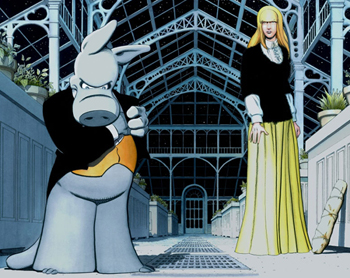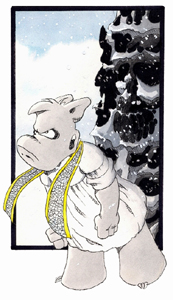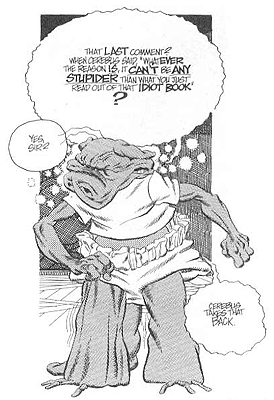A Funny-Animal Comic Book: Cerebus
Published on July 30th, 2008 in: Comics, Issues, Underground/Cult |
All images © Dave Sim
What’s That Large Grey Thing In The Corner?
And now we come to the elephants in the room, although these elephants are quickly becoming the identifying feature of the series.
Elephant #1: Sim’s Sanity
In 1979, Dave Sim started taking LSD and was hospitalized after a days-long binge. Sim also revealed that he had suffered a schizophrenic episode, during which he decided that Cerebus would last 300 issues and end with the death of the protagonist. Although there are various events and concepts in the story that might be connected to Sim’s mental fragility, it’s not until later in the series that the disconnect between the events and the story’s established “reality” is strongly felt.
In the most visible case, Sim and Cerebus both begin an obsessive study of the Torah. In real life, this resulted in Sim constructing and following his own amalgam of Christianity, Judaism, and Islam. In the comic this translates into eight full issues of Cerebus interpreting Scripture, culminating in one which steps through the first Creation story in Genesis and explains it, in terms of science and Sim’s own Gnostic/Manichaean religion, as a battle between the true (male) God (called “Elohim” in the Bible) and a female portion of God’s spirit (called “YHWH” in the Bible) who thinks she is God. The female force works through women and weak men to defeat God and establish her own rule. And this leads us into the next elephant in the parade. . .

All images © Dave Sim
Elephant #2: Misogyny
Though his views on women were hinted at in his “Notes from the President,” it was issue 186 where things came to a head. The issue was composed of five pages of drawn comic and eleven pages of text in which “Viktor,” an alter-ego, explained how women were hungry voids who devoured the creative light that was man. The issue’s graphics, on the other hand, contained one of the most exciting examples of physical combat on paper. Sim’s later work, although not as unsubtle as issue 186, continued the theme, eventually reducing a strong female character to a shallow mall-shopping caricature. The rest of Cerebus is still interesting to a certain extent, but so much of the wind is knocked out of its sails by #186 that the second half pales in comparison.
This issue and the theory behind it have so divided the comics community and have loomed so large in Sim’s mind that he will no longer associate with anyone who has not signed an Internet petition affirming that Sim is not a misogynist. Formerly accessible by fans at conventions and through the mail, he has canceled all public appearances since he has begun the petition. “Cerebus is one man’s journey towards truth,” Liss observes, still a fan despite the views expressed in the latter part of the series. “I’ve used what I’ve picked up along this journey as different building blocks in formulating my own opinions. . . The positives that I acquire from reading Cerebus outweigh what I think of, and my disagreements with, Sim’s opinions. . . ”
At my local comic shop, I spent some time talking with the clerk, who had not read Cerebus yet but knew enough about it to lament that as important as the series is, it seems doomed to be remembered for the elephants alone. All I could say was that despite its later failings, Cerebus is worth the journey. It’s not fair to paint all 6,000 pages with the brush of the last third, but the most recent events are the ones that linger.
Recommendations:
I encourage people to give the series a chance, even if you only read the first half. It contains everything that is good about comics, about storytelling. As Liss says, “[a]long the 300-issue tale, Sim will make you laugh, cry, and ponder the different topics he raises, from religion’s role in politics to the ‘code for guys’ and even a romantic twist or two thrown in.” I recently finished my latest read-through of the series, and I can attest to the truth of that statement. Each time I read it, I find more to think about, and I am grateful for the journey.
I’d obviously like everyone to start from Book 1—Cerebus—but if you want to get right to the meat (and skip the development of the art and story), start with Book 2—High Society—and enjoy the madcap antics. Stay with it.
If you must, skip Book 6—Melmoth—which is a slim volume that inexplicably depicts the death of Oscar Wilde. Cerebus himself is not a main character, but his story picks up in Book 7,—Women.
You might also skip most of the text in Book 9—Reads—since little of it has to do with Cerebus’ actual story, and the Torah commentary in Book 15—Latter Days. It pains me to even consider skipping any part of this story, since it’s all one piece, but if that gets people to read Cerebus, I’m okay with the compromise.

All images © Dave Sim
Additional Resources:
The Cerebus Wiki: which contains boundless information about the books, with summaries (including spoilers) of every issue.
The Cerebus Fangirl Site: stores information from the Yahoo! Groups discussions of the books, an exhaustive list of Cerebus appearances, and more.
The Wikipedia article on Cerebus is very good, and covers the history of the book along with short synopses of the phonebooks.
Pages: 1 2
Time limit is exhausted. Please reload the CAPTCHA.